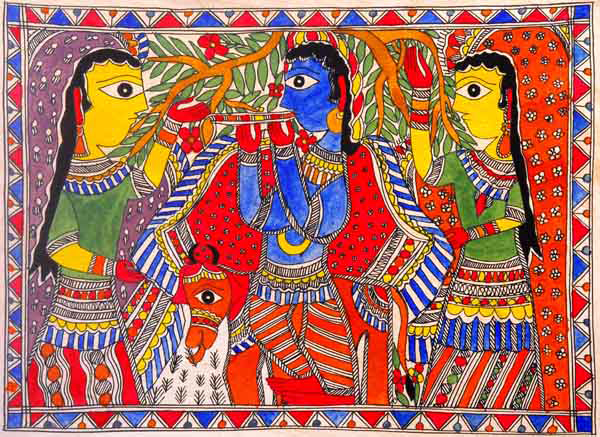Shop Now:
It was many years before the rich tradition of folk art and paintings in India came to be recognized. In India almost every region has developed its own style of art. The cave paintings of Bhimbetka, from the mythological association with Bhima (one of Pandava brothers) contains rock paintings which are about 9000 years old and among oldest in the world. India has a rich culture of art from the time immemorial. There are lots of famous folk arts and styles in this country, today I have come up with five of most famous styles and art forms of India. These are as follows:
Madhubani Paintings:
By far this is the most talked about and famous form of folk art in India. Madhubani originates from the Mithila region of Bihar. According to Hindu belief, at the time of marriage of Sita to Rama, King Janaka of Mithila commissioned the artists to do these paintings. Since then, Madhubani has been painted mostly on the floors and walls of their houses especially during important festivals, Marriages, child birth etc.
Madhubani is painted mainly with the aim of pleasing god and thus the themes are around religion and pictures of Hindu deities such as Shiva, Sita, Rama etc. Natural elements, serpents(protectors) etc also occur. Use of colors in these paintings varies from style to style.
 |
| Madhubani Paintings |
 |
| Madhubani Paintings2 |
Warli Paintings:
This is one of the most symbolic and simplest forms of tribal paintings in India. Warli traces its roots to a tiny tribe in Maharashtra called the Warli tribe. Warli paintings are mostly consists of men, women, tress, birds etc on a mud-based walls of their houses. Using relatively simple color scheme of bright white against an earthen background, the paintings centre around a circle or a spiral, symbolizing the circle of life. They does not have mythological and religious figures.
 |
| Warli Paintings1 |
 |
| Warli Paintings 2 |
Pata Chitra:
These type of paintings hail from Orissa, have popularized god and encouraged worship amongst the common people. The name ‘Pata’ is derived from the material on which these paintings are made, a piece of cloth. The study of these paintings portrays the strong relationship that man shares since time immemorial with the divine. Pata Chitra Paintings are now being done on a variety of different media such as masks, toys etc.
 |
| Pata Chitra |
Phad Paintings:
From Rajasthan, these paintings are usually done on cloth in the form of scroll and are world-renowned for their unique style and vibrancy. The Phads mostly depict the heroic deeds and exploits the local rulers and warriors such as the gallant Rajput warrior Prithviraj Chauhan, Amar Singh Rahore in the form of stories painted on long scrolls (an average Phad scroll is about 30 feet long). Traditionally only vegetable dyes were employed while painting Phads, but artists nowadays have started using modified waterproof earthen colors.
 |
| Phad Paintings1 |
Kalamkari Paintings:
Kalamkari means ‘art done with the help of pen (kalam)’. Originating about 3000 years ago, this form of folk painting has been kept alive in Andhra Pradesh through generations by essentially two schools of painting- Masulipatnam and Srikalahasti(deriving their names from the place of origin). The Masulipatnam School reflects the influence of Muslim rule in Golconda, as seen by the use of intricate Persian motifs and designs.
The Kalamkari differs from other art forms like Phad, Madhubani, Pata Chitra etc due to the use of mellow, non bright and non-contrasting color schemes.
 |
| Kalamkari1 |
 |
| Kalamkari 2 |
Other art forms in India include Tanjore paintings, Pahari, Tibetan Scroll, Rajasthani paintings, glass paintings, Bandhni Print work, Alpana floor works and Kalamajhethu etc.
Shop Now:

























0 Comments